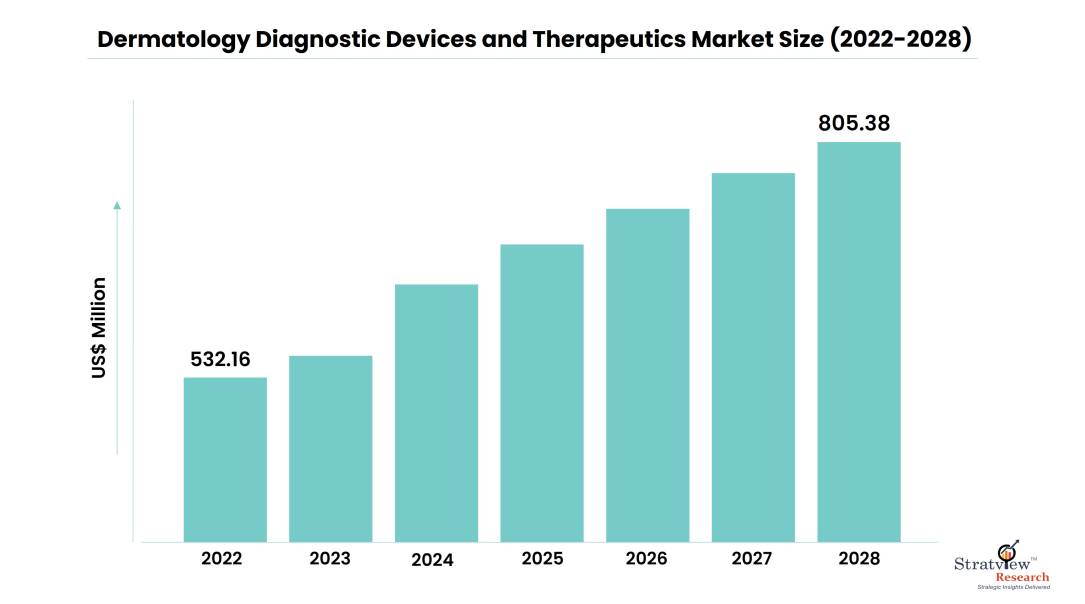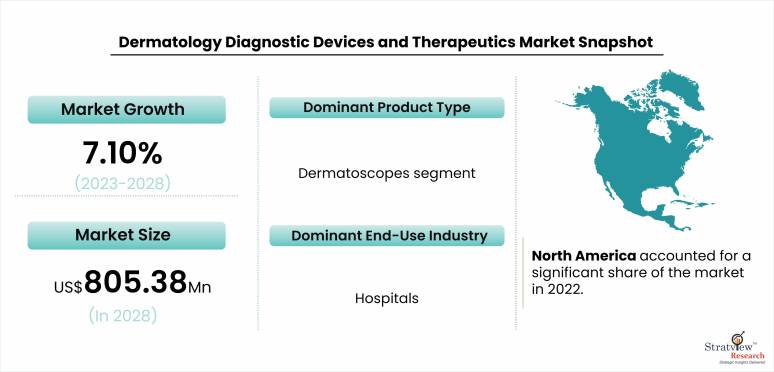Market Insights
The dermatology diagnostic devices and therapeutics market is estimated to grow from USD 532.16 million in 2022 and is likely to grow at a CAGR of 7.10% during 2023-2028 to reach USD 805.38 million by 2028.

Wish to get a Free Sample? Register Here.
What are dermatology diagnostic devices and therapeutics?
Dermatology deals with skin and its appendages such as hairs, nails, sweat glands, and others. Primary skin care and skin hygiene are prime concerns of urbanization. A polluted environment results in a large number of skin allergies, which trigger several chronic diseases such as skin cancer. Dermatological diagnostic devices and therapeutics are primarily used for identifying & monitoring skin conditions.
|
Dermatology Diagnostic Devices and Therapeutics Market Report
|
|
Market Size in 2028
|
USD 805.38 Million
|
|
Market Size in 2022
|
USD 532.16 Million
|
|
Market Growth (2023-2028)
|
CAGR of 7.10%
|
|
Base Year of Study
|
2022
|
|
Trend Period
|
2017-2021
|
|
Forecast Period
|
2023-2028
|
Key Players
The following are the key players operating in the global dermatology diagnostic devices and therapeutics market are-
- Agfa (Belgium)
- Astellas Pharma (Japan)
- Galderma (Switzerland)
- Genentech (US)
- Stiefel (US)
- LEO Pharma (Denmark)
- Michelson Diagnostics (UK)
- Novartis (Switzerland)
- Valeant Pharmaceuticals (Canada)
- Canfield Scientific (US)
Market Dynamics
The dermatology diagnostic devices and therapeutics market is driven by a host of factors, some of which are noted below:
The growing prevalence of skin disorders as well as rising awareness of aesthetic procedures spurs the market.
The surging demand for aesthetic procedures augments the demand for aesthetic lasers & cosmetic dermatology.
These lasers are widely used in aesthetic procedures such as skin rejuvenation, hair removal, psoriasis, acne, wrinkle removal, tattoo removal, vascular lesions, skin resurfacing, and pigmented lesions, among other skin diseases.
Lasers with longer wavelengths and better configurations have widened the range of beauty treatments, thus making the aesthetic laser industry profitable.

To Get the full scope of the report, Register Here.
Opportunities:
The rise of personalized medicine is creating new opportunities for the development of diagnostic devices and therapeutics that can be tailored to the specific needs of individual patients.
The increasing use of artificial intelligence (AI) and machine learning is enabling the development of more accurate and efficient diagnostic devices.
The growing demand for at-home diagnostic devices is creating new opportunities for companies that can develop affordable and easy-to-use devices that can be used by patients in the comfort of their own homes.
Challenges:
The high cost of developing new diagnostic devices and therapeutics can be a barrier to entry for small and medium-sized companies.
The regulatory approval process for new diagnostic devices and therapeutics can be lengthy and expensive.
The lack of reimbursement for some diagnostic devices and therapeutics can make it difficult for patients to afford them.
Segment Analysis
Product Trends
The market has been classified into dermatoscopes, microscopes and trichoscopes, and imaging equipment. The dermatoscopes segment accounted for the largest market share in 2022 & is expected to remain dominant during the forecast period. Dermoscopy helps to improve the diagnostic sensitivity, accuracy, and specificity of skin cancer diagnosis by dermatologists. Also, it is useful to dermatologists in differentiating benign from cancerous lesions, specifically in the diagnosis of melanoma, thereby augmenting segment growth.
End Use Trends
The market has been classified into hospitals, clinics & research institutions. The hospital sector occupied the highest share of the market in 2022 & is expected to grow at a robust CAGR during the forecast period. Owing to the widespread use of cutting-edge dermatological technology in hospital settings. As a result of the availability of a variety of treatment options, numerous visits are made to these facilities for the diagnosis and treatment of skin problems, which stimulates the segment's growth. The end-user category for clinics is expected to grow at the quickest rate between 2022 and 2028. Dermatology offices are clinics that specialize in the diagnosis and treatment of skin problems. In dermatological clinics, certified plastic surgeons perform both surgical and nonsurgical procedures.
Regional Analysis
North American dermatology diagnostic devices and therapeutics market accounted for a significant share in 2022 and is expected to grow at a robust CAGR during the review period. The market growth is mainly attributed to growing incidences of skin cancer & other skin diseases, such as rosacea and eczema. A significant number of skin cancer cases are found in the US, which further bolsters regional market growth. The Asia Pacific is expected to grow at a healthy CAGR during the review on account of the growth of the major end-use industries. This growth is mainly attributed to increasing awareness regarding skin diseases coupled with government support for investments in R&D activities to cure skin cancer in the region.
Segmentation
This report studies the market covering a period of 12 years of trend and forecast. The report provides detailed insights into the market dynamics to enable informed business decision-making and growth strategy formulation based on the opportunities present in the market.
The dermatology diagnostic devices and therapeutics market is segmented into the following categories:
By Product
- Dermatoscopes
- Microscopes and Trichoscopes
- Imaging Equipment
By End Use
- Hospitals
- Clinics
- Research institutions
By Region
- North America (Country Analysis: The USA, Canada, and Mexico),
- Europe (Country Analysis: Germany, France, The UK, Russia, and the Rest of Europe),
- Asia-Pacific (Country Analysis: China, India, Australia, South Korea, and the Rest of Asia-Pacific),
- Rest of the World (Country Analysis: Saudi Arabia, Brazil, and Others).
Report Features
This report provides market intelligence in the most comprehensive way. The report structure has been kept such that it offers maximum business value. It provides critical insights into the market dynamics and will enable strategic decision-making for the existing market players as well as those willing to enter the market.
What Deliverables Will You Get in this Report?
|
Key questions this report answers
|
Relevant contents in the report
|
|
How big is the sales opportunity?
|
In-depth Analysis of the dermatology diagnostic devices and therapeutics market
|
|
How lucrative is the future?
|
The market forecast and trend data and emerging trends
|
|
Which regions offer the best sales opportunities?
|
Global, regional, and country-level historical data and forecasts
|
|
Which are the most attractive market segments?
|
Market segment analysis and Forecast
|
|
Which are the top players and their market positioning?
|
Competitive landscape analysis, Market share analysis
|
|
How complex is the business environment?
|
Porter’s five forces analysis, PEST analysis, Life cycle analysis
|
|
What are the factors affecting the market?
|
Drivers & challenges
|
|
Will I get the information on my specific requirement?
|
10% free customization
|
Target Audience
The target audience of the dermatology diagnostic devices and therapeutics market includes-
- Vendors
- Manufacturers
- Distributors
- Organizations
- Government Bodies.
Covid-19 Impact Analysis
The outbreak of COVID-19 negatively affected the dermatology diagnostic devices and therapeutics industry. The pandemic has adversely impacted consumer behavior, with many upcoming beauty trends fast-forwarded and usage patterns and new purchases appearing. Telehealth became a suitable solution for many dermatological practices. Also, non-urgent clinical and surgical procedures were postponed, thus affecting the industry's growth.
Research Methodology
This report offers high-quality insights and is the outcome of a detailed research methodology comprising extensive secondary research, rigorous primary interviews with industry stakeholders, and validation and triangulation with Stratview Research’s internal database and statistical tools. More than 1,000 authenticated secondary sources, such as company annual reports, fact books, press releases, journals, investor presentations, white papers, patents, and articles have been leveraged to gather the data. We conducted more than 10 detailed primary interviews with the market players across the value chain in all four regions and with industry experts to obtain both qualitative and quantitative insights.
Customization Option
Stratview Research offers one of the following free customization options to our respectable clients:
Company Profiling
- Detailed profiling of additional market players (up to three players)
- SWOT analysis of key players (up to three players)
Competitive Benchmarking
Benchmarking of key players on the following parameters: Product portfolio, geographical reach, regional presence, and strategic alliances
Custom Research: Stratview Research offers custom research services across sectors. In case of any custom research requirement related to market assessment, competitive benchmarking, sourcing and procurement, target screening, and others, please send your inquiry to sales@stratviewresearch.com.

